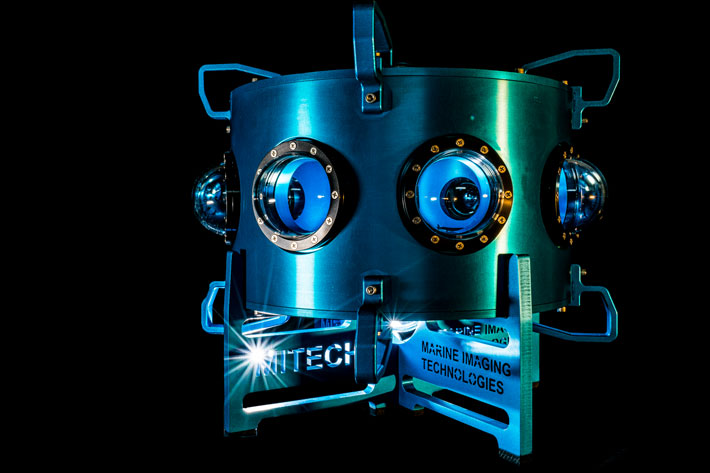
The first ultra-low-light underwater VR camera, HYDRUS VR, uses SONY’s low-light camera, the UMC-S3CA, paired with custom SLR Magic E-Mount lenses to capture imagery never seen before.
Back in November 2017 Marine Imaging Technologies (MITech), a leader in developing state-of-the-art underwater optical imaging platforms, announced the imminent launch of a new high-resolution cinema camera system for up to 6,500m in the deep oceans. MITech, working with the Advanced Imaging and Visualization Laboratory (AIVL) at Woods Hole Oceanographic Institution, developed the UHD Cinema System to support deep-sea uses of a wide range of state of the art cinema and studio quality cameras. The UHD Cinema System will allow, says MITech, an unprecedented quality of picture from some of the deepest depths of earth’s oceans.
https://youtu.be/b9e3oljEk4A
By the end of November the same year, the company introduced Pixel, the first “cinema class” ROV, which enables DPs and storytellers to capture cinema-quality footage beyond SCUBA depths by merging top cinema technologies with advanced underwater filming techniques. Pixel is, according to MITech, a multi-camera underwater filming and exploration platform that will facilitate deep water and coastal storytelling unlike ever before, enabling storytellers to record cinema quality images while minimizing the associated hazards and costs.
Pixel, as well as other forthcoming ROVs in MITech’s Cinema Class line, simultaneously hosts multiple cameras with live video and control feeds. From Ultra Hi Def (UHD) and large format stills to stereoscopic and Virtual Reality, Pixel’s versatility broadens the choices for aquatic storytellers. The promise of Pixel is ambitious: to “reimagine deep sea cinema”,
“Telling stories about underwater is always a challenge, but once you enter deeper water where diving becomes less feasible, there simply were no options for true cinema class filming,” says Evan Kovacs, founder of Marine Imaging Technologies. “To that end, the Pixel platform has been designed from the bottom up to accommodate not only the exciting cinema quality we’ve all become accustomed to, but also to lessen the burden on the filming budget. We’re thrilled with Pixel and think it will be a game-changer in the industry.”
Now MITech takes underwater cinematic storytelling further (or deeper) with the introduction of HYDRUS VR, their new 8k underwater cinematic virtual reality system. Created to push the envelope of underwater VR for the next generation of storytellers, HYDRUS VR incorporates the newest version of the famous SONY low-light camera, the UMC-S3CA, and custom SLR Magic E-Mount lenses to provide unparalleled dynamic range and clarity. While virtual reality as a storytelling method is on the verge of becoming mainstream, MITech’s HYDRUS VR was designed to offer that same experience in an underwater environment, both for the audience and the storyteller.
“Cinematic VR is the next step in a continually evolving artistic struggle to not just show people unique underwater landscapes and the stories within them, but to also immerse and transport them in a way that captures their imaginations and senses on all levels,” says Evan Kovacs, founder of MITech. “As passionate fans of cinema, we couldn’t be more excited about the possibilities that HYDRUS VR holds for creating immersive stories about and all aspects of our underwater world.”
HYDRUS VR was over two years in the making. Conceived and designed in 2016, the prototype was built in the Cape Cod facilities in 2017. After discussions with SONY, the camera array was redesigned to facilitate the soon to be released SONY UMC S3CA, their popular UMC cinema camera with their newest low light sensor. By March of 2018, production partner Digital Quilt was stitching test footage of reefs off the Cayman Island and HYDRUS VR has just returned from the Isle Royale in the Great Lakes.
Designed to be simple and intuitive, the camera allows the storyteller to focus on the subject and the story. It can be diver operated, but with a depth rating of 300m, it can be incorporated onto underwater robots as well. Some features include:
- 8-12K stitched spherical and 3D resolution
- A custom control system for camera presets, on-the-fly exposure control, and a visual sync point for all cameras.
- Real time monitoring of the primary camera or multiple cameras.
- Visual and audio alarms for vacuum loss and water intrusion.
“We are very excited to help tell interesting stories and work with our partners to create an unforgettable experience, an experience that will make audiences feel inspired to cherish, save and protect — and even one day visit — these underwater environments,” says Kovacs.
Eight Cameras in a horizontal radial array with 60 percent overlap and two more cameras on a vertical axis in the nadir, with each camera capturing a 3840×2160 image, allows the HYDRUS VR to produce both a stitched image resolution of 8192 x 4096 spherical at 30 frames and Stereo 4k. With Genlock tri-level sync, XAVCS 4K recording format and 8+ hours recording time, the HYDRUS VR is, says MITech, the “right tool for the virtual underwater experience” whether for storytelling or research.
If the subject interests you, Provideo Coalition has covered the theme before. Find more reading about other underwater filming solutions in the articles Nemo, Titan and Mito: three new 4K underwater drones for filmmakers and Trident: a drone for underwater video.
